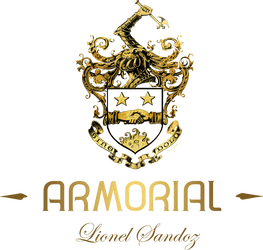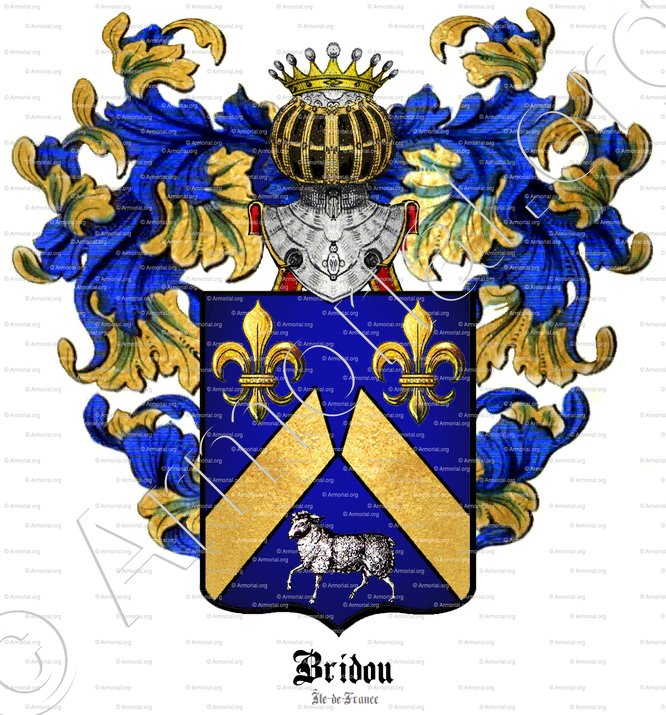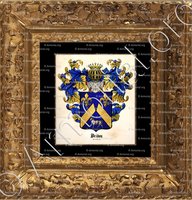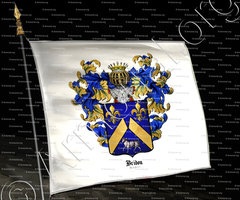DESCRIPTION
BRIDOU
Île-de-France
France
BRIDOU, ancienne famille noble de France.
Armoiries :
" D'azur, au chevron brisé d'or, accompagné en chef de deux fleurs de lys du même, et en pointe d'un mouton d'argent. "
Sources :
- Nobiliaire universel de France... par M. de Saint-Allais (Nicolas Viton), 1815.
Autres documents héraldiques :
- Pierre BRIDOU, procureur au Parlement en 1696, Bailli de Villeneuve-le-Roi et Ablon en 1726.
" D'azur, au chevron d'argent accompagné en pointe d'une brebis passant de même, et deux molettes d'or en chef. "
- Arnoud BRIDOU, ancien chanoine de l'église cathédrale d'Arras à la fin du XVIIe s.
" D'azur, au chevron d'argent accompagné en pointe d'une brebis passant de même. "
Sources :
- Armorial de la Généralité de Paris dressé par Charles d'Hozier en exécution de l'édit de novembre 1696, par Meurgey de Tupigny, 1965-67.
- Note historique sur Pierre BRIDOU :
...... vu l'expédition d'une Sentence rendue par M. Pierre BRIDOU, Procureur au Parlement, alors Bailli desdites Villeneuve-le-Roi et Ablon, le 14 janvier 1726, sur la Requête à lui présentée par Pierre Gibert, alors Marguillier en charge de ladite Chapelle d'Ablon, laquelle Sentence homologue une Délibération desdits Habitants d'Ablon du 6 dudit mois de janvier, pour être exécutée selon sa forme et teneur, ordonne que ledit Gibert et ses Successeurs Marguilliers en charge de l'Église dudit Ablon fourniront seuls, et à l'exclusion de tous autres, les planches nécessaires pour la décharge des marchandises de vin et autres, arrivant au Port dudit Ablon, et pour la décharge ....
Sources : - Ablon-sur-Seine, recherches historiques ..., par Pierre Bonnin, 1890.
(Ablon-sur-Seine, anciennement Ablon, aussi orthographié Ablons, est une commune française située dans le département du Val-de-Marne en région Île-de-France.
L'ancienne province correspondant à l'actuel Val-de-Marne sous la monarchie était principalement la province de l'Île-de-France. Cependant, certaines parties de ce territoire appartenaient aussi aux provinces de la Brie et du Hurepoix.)
Étymologie :
Le suffixe "-ou" est souvent utilisé dans les noms de famille français comme un diminutif ou pour indiquer une forme affectueuse. "BRIDOU" pourrait donc être une forme familière ou diminutive d'un autre nom.
"BRIDOU" pourrait être une variation ou une déformation d’un autre nom de famille plus courant. Par exemple, il pourrait s’agir d'une altération du nom "Brideau" ou "Bridault", où "Brid-" pourrait venir de "bride" (une pièce de harnais pour les chevaux) indiquant un lien avec le travail équestre ou les métiers liés aux chevaux.
Toponyme :
- BRIDOU, nom d'un ancien fief seigneurial, des chevaliers et barons Moreau de Bellaing, originaire de la Hesbaye, à l'époque de la Révolution.
Personnalités dans l'histoire :
- Raoul BRIDOU, cité à Paris sur le livre de la taille de Paris, Paroisse Saint-Sauveur, Porte Saint-Denis, en 1284.
- Isabeau BRIDOU, épouse de Pierre Le Fayel, citée sur un acte devant notaire de Rouen le 1er juillet 1550.
- Guillaume BRIDOU, perruquier célèbre de l'Électeur de Brandebourg, originaire de Paris, protestant, réfugié avec sa fille à Berlin dans les années 1698.
- Pierre BRIDOU d'Amiens, protestant, s'était retiré en Hollande et de là était allé dans les Indes. (La France protestante: ou Vies des protestants français qui se sont fait un nom dans l'histoire depuis les premiers temps de la Réformation jusqu'à la reconnaissance du principe de la liberté des cultes par l'Assemblée nationale, par MM. Haag, 1846-1859.)
- A. BRIDOUX, artiste graveur, connu pour une superbe épreuve du roi Louis-Philippe I, d'après Winterhalter. (Catalogue d'une belle collection d'estampes, par de Vereeniging, A.G. de Visser, 1868.)
- Épiphane BRIDOU, né en 1878, décédé ?, ouvrier de tannerie.
Note historique et biographique :
- 1660. Déclaration à l'abbé de Neaufle par Pierre BRIDOU, écuyer, seigneur censier dans le village de Galluis (Titres de l'abbaye de Neaufle).
Pierre BRIDOU, écuyer, doyen des trente-six gentilshommes ordinaires de la chambre du roi, marguillier honoraire de l'église Saint-Pierre de Montfort. Il mourut le 17 décembre 1722, à l'âge de 82 ans. De Madeleine Macqueron, il eut Pierre-Denis, né en 1666, qui suit, et Marie, née en 1665, mariée à Jacques Le Clerc, écuyer, gentilhomme de Madame de Montpensier; morte veuve à 74 ans, le 26 août 1739.
Pierre-Denis BRIDOU, écuyer, sieur de Mignon, gentilhomme servant ordinaire du roi, se dit parfois sieur du fief de Mignon à Galluis, ou seigneur censif et patron de l'école dans le village de Galluis. Il est en effet à l'origine d'une fondation importante en faveur de cette école. De Marie-Louise-Aimée de Noircourt, femme de chambre de la défunte reine d'Espagne, il eut huit enfants, tous morts jeunes, sauf deux : Madeleine, née en 1696, mariée d'abord à 47 ans, en 1742, à Eustache-Jean d'Article, âgé de 65 ans et mort en 1746 ; puis, en 1755, à 59 ans, à Paul Le Lorrain, écuyer, âgé de 34 ans. Elle mourut le 18 juillet 1762. Louis-Joseph, né le 24 décembre 1703, était en 1734 abbé commendataire de l'abbaye de Selle ; il se dit en 1732 et 1746 écuyer, seigneur de Belleville. Il assiste le 23 décembre 1746 à l'inhumation, à Montfort, de son père, mort à l'âge de 80 ans (Titres du château de Galluis).
Les BRIDOU dans l'histoire de la France protestante :
Branche protestante:
Les notes de Dieterici indiquent : « Marie, veuve de Guillaume BRIDOU, de Paris, perruquier, réfugiée avec une fille à Berlin, 1698 » ; et Jean, passementier à Paris (3 personnes) idem 1700. (Charles) religionnaire fugitif d'Amiens, 1686 (TT 235). - Note de la Bourse française de Genève : « Pierre BRIDOU, d'Amiens, qui s'était retiré en Hollande et de là était allé pour trafiquer dans les Indes, ayant été, à son retour, naufragé sur les côtes du Portugal, un vaisseau de cette nation l'a ramené en France où il a été dépouillé de tout. Assisté d'habits et d'un écu pour aller rejoindre sa famille en Hollande », 1700 ; assisté d'un viatique de 7 florins pour le Brandebourg, 1702.
(La France protestante, vol.3, par Eugène Haag, Émile Haag, 1877.)
_______________________________________________
BRIDOU
Île-de-France
France
BRIDOU, an old noble family of France.
Coat of Arms:
"Azure, a broken chevron Or, accompanied in chief by two fleurs-de-lys of the same, and in base by a lamb Argent."
Sources:
- Universal Nobility of France... by M. de Saint-Allais (Nicolas Viton), 1815.
Other Heraldic Documents:
- Pierre BRIDOU, attorney at the Parliament in 1696, Bailiff of Villeneuve-le-Roi and Ablon in 1726.
"Azure, a chevron Argent accompanied in base by a passant ewe of the same, and two mullets Or in chief."
- Arnoud BRIDOU, former canon of the cathedral church of Arras at the end of the 17th century.
"Azure, a chevron Argent accompanied in base by a passant ewe of the same."
Sources:
- Armorial of the Generality of Paris compiled by Charles d'Hozier in execution of the edict of November 1696, by Meurgey de Tupigny, 1965-67.
Historical note on Pierre BRIDOU:
...... seen the expedition of a Sentence rendered by Mr. Pierre BRIDOU, Attorney at the Parliament, then Bailiff of said Villeneuve-le-Roi and Ablon, on January 14, 1726, on the Petition presented to him by Pierre Gibert, then Churchwarden in charge of said Chapel of Ablon, which Sentence homologates a Deliberation of said Inhabitants of Ablon of the 6th of said month of January, to be executed according to its form and content, orders that said Gibert and his Successors as Churchwardens in charge of the Church of said Ablon will alone, and to the exclusion of all others, provide the necessary boards for the unloading of wine and other goods arriving at the Port of said Ablon, and for the unloading...
Sources: - Ablon-sur-Seine, historical research ..., by Pierre Bonnin, 1890.
(Ablon-sur-Seine, formerly Ablon, also spelled Ablons, is a French commune located in the Val-de-Marne department in the Île-de-France region.
The former province corresponding to the current Val-de-Marne under the monarchy was mainly the province of Île-de-France. However, some parts of this territory also belonged to the provinces of Brie and Hurepoix.)
Etymology:
The suffix "-ou" is often used in French family names as a diminutive or to indicate an affectionate form. "BRIDOU" could therefore be a familiar or diminutive form of another name.
"BRIDOU" could be a variation or deformation of another more common family name. For example, it could be an alteration of the name "Brideau" or "Bridault," where "Brid-" might come from "bride" (a piece of harness for horses) indicating a link to equestrian work or trades related to horses.
Toponym:
BRIDOU, name of an old seigneurial fief, of the knights and barons Moreau de Bellaing, originating from Hesbaye, at the time of the Revolution.
Personalities in History:
- Raoul BRIDOU, mentioned in Paris in the tax record book of Paris, Saint-Sauveur Parish, Porte Saint-Denis, in 1284.
- Isabeau BRIDOU, wife of Pierre Le Fayel, mentioned in a notarial act in Rouen on July 1, 1550.
- Guillaume BRIDOU, famous wigmaker of the Elector of Brandenburg, originally from Paris, Protestant, exiled with his daughter to Berlin in the 1690s.
- Pierre BRIDOU of Amiens, Protestant, had taken refuge in Holland and from there went to the Indies. (Protestant France: or Lives of French Protestants who made a name in history from the early times of the Reformation to the recognition of the principle of religious freedom by the National Assembly, by MM. Haag, 1846-1859.)
- A. BRIDOUX, artist engraver, known for a superb proof of King Louis-Philippe I, after Winterhalter. (Catalogue of a beautiful collection of prints, by de Vereeniging, A.G. de Visser, 1868.)
- Epiphane BRIDOU, born in 1878, died?, tannery worker.
Historical and Biographical Note:
- 1660. Declaration to the abbot of Neaufle by Pierre BRIDOU, squire, lord tenant in the village of Galluis (Titles of the abbey of Neaufle).
Pierre BRIDOU, squire, dean of the thirty-six ordinary gentlemen of the king's chamber, honorary churchwarden of the church of Saint-Pierre de Montfort. He died on December 17, 1722, at the age of 82. From Madeleine Macqueron, he had Pierre-Denis, born in 1666, who follows, and Marie, born in 1665, married to Jacques Le Clerc, squire, gentleman of Madame de Montpensier; died a widow at 74 years old, on August 26, 1739.
Pierre-Denis BRIDOU, squire, lord of Mignon, ordinary serving gentleman of the king, sometimes called lord of the fief of Mignon in Galluis, or lord tenant and patron of the school in the village of Galluis. He is indeed at the origin of an important foundation in favor of this school. From Marie-Louise-Aimée de Noircourt, lady's maid of the late Queen of Spain, he had eight children, all died young, except two: Madeleine, born in 1696, first married at 47 years old, in 1742, to Eustache-Jean d'Article, aged 65 and died in 1746; then, in 1755, at 59 years old, to Paul Le Lorrain, squire, aged 34. She died on July 18, 1762. Louis-Joseph, born on December 24, 1703, was in 1734 commendatory abbot of the abbey of Selle; he called himself in 1732 and 1746 squire, lord of Belleville. He attended the burial, on December 23, 1746, in Montfort, of his father, who died at the age of 80 years (Titles of the Galluis castle).
The BRIDOU in the history of Protestant France:
Protestant branch:
Dieterici's notes indicate: "Marie, widow of Guillaume BRIDOU, of Paris, wigmaker, exiled with a daughter to Berlin, 1698"; and Jean, passementier in Paris (3 people) idem 1700. (Charles) religious fugitive from Amiens, 1686 (TT 235). - Note from the French Stock Exchange in Geneva: "Pierre BRIDOU, from Amiens, who had taken refuge in Holland and from there had gone to trade in the Indies, having been, on his return, shipwrecked on the coasts of Portugal, a ship of that nation brought him back to France where he was stripped of everything. Assisted with clothes and a crown to join his family in Holland", 1700; assisted with a viaticum of 7 florins for Brandenburg, 1702.
(Protestant France, vol.3, by Eugène Haag, Émile Haag, 1877.)
SHARE ON SOCIAL NETWORKS
OPINIONS
There are no notes at this time. Be the first to rate!
GIVE A NOTE








